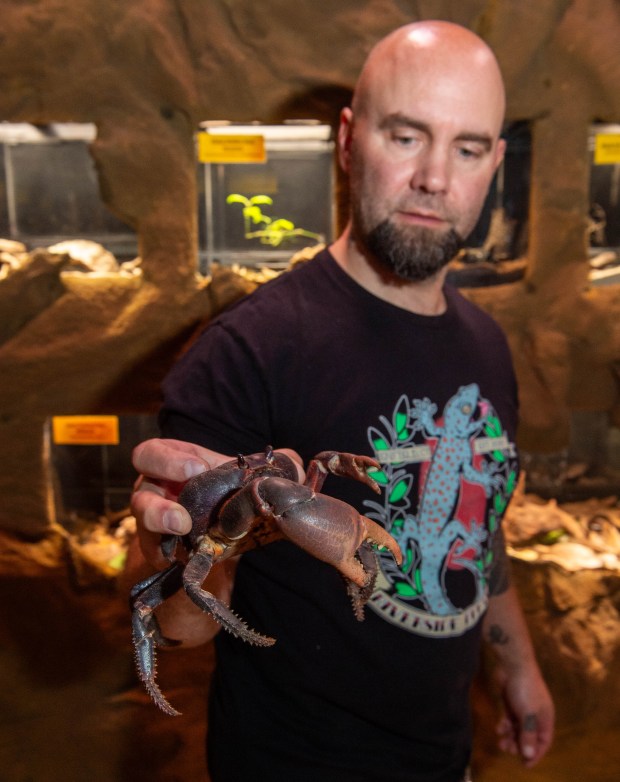Blood
New exhibit at CT museum: Venomous scorpions, exotic spiders and blood-sucking leeches
Riverside Reptiles Education Center in Enfield has some new residents on view: several different types of insects from around the world including some with hundreds of legs, deadly venom, and even a few as big as a human hand.
The insects are part of the center’s Bug Cave, an impressive collection of approximately 31 exhibits featuring both local and exotic insects inside a 450 square-foot faux-rock installation that’s meant to resemble an actual cave. The new exhibit is permanent and will be open year-round.
“When I first designed the center, I always wanted to do a section on invertebrates,” said Brian Kleinman, the center’s owner. “Simply because a lot of times they’re lumped with reptiles and amphibians because people are scared of them. Spider phobias are just as big as snake phobias. Oftentimes people will have both.”
Kleinman, a self-professed insect nerd, said he has always found the creatures fascinating and even took entomology courses in college. The center’s main attraction are reptiles, and Kleinman, formerly an animal curator for The Children’s Museum in West Hartford, is now the steward of 60-plus reptiles at the 13,000-square-foot center at 132 South Road. He collects animals on his own and is trusted by DEEP, UConn and the Audubon Society to take in animals they can’t keep.
“I wanted to do this exhibit to show the diversity in invertebrates, as well as help wash people’s fears of them, especially spiders and cockroaches,” Kleinman said. “We also want to teach people that the ecosystem would basically collapse without insects. The food chain itself relies on them. Most insects are at the bottom of the food chain. We would lose birds, bats, and even fruits and vegetables that rely on pollinators.”
The idea for the bug cave came several years ago but then the pandemic hit. Kleinman said that he had to abandon his dream due to financial losses until receiving a grant for $10,000 from the town of Enfield. The money was part of the town’s federal COVID-19 relief ARPA dollars. Kleinman and a friend have been building the cave by hand since the summer with the total cost of construction around $13,000, according to Kleinman.
“I don’t even know how many hours we put into it. There were many long days,” Kleinman said. “We made it look a lot like a cave. We wanted to ensure it has that feel.”
Among the many creepy crawlies are spiders, scorpions, centipedes, millipedes, praying mantis, and cockroaches spanning several continents and many corners of the globe. But Kleinman said that he also plans on adding more local insects as part of the educational experience.

“We have a giant bird-eating spider, which is one of the largest tarantulas in the world,” Kleinman said. “She right now has a leg span of around 7 to 8 inches but they can get up to 10 inches. I’ve even seen some as big as 11 inches.”
The Goliath bird-eater tarantula is found in South America and the Amazon rainforest. Despite its name, it rarely feeds on birds and instead opts for rodents, frogs, toads, and lizards to feed on. Other spiders at the exhibit include the giant huntsman spider native to Laos and Malaysia. The giant huntsman is considered one of the largest spiders in the world, according to Kleinman.
“Our giant huntsman is a true spider and not a tarantula,” Kleinman said. “It has a leg span of about 4 to 5 inches. So it’s really neat to see a true spider of that size.”
One of the more venomous creatures in the exhibit is the African black fat-tailed scorpion. The scorpion uses neurotoxic venom, which is fast acting and attacks the central nervous system. Just one sting can be lethal to a human being, according to Kleinman.
“They’re small at only about 3 inches long,” Kleinman said. “Some scorpions have venom that is not considered medically significant, it’s like a bee sting. But then there’s these guys where if they sting you it’s considered medically significant. There have been human deaths attributed to this species before.”

Other creatures that can be viewed include a giant Vietnamese centipede, blood-sucking leeches, and a Chinese mantis that was introduced to the state in the early 20th century. Despite it being non-native, it is not considered an invasive species, according to Kleinman. The state has two different types of mantis, including the more familiar green European mantis and the Chinese mantis, both non-native, according to the Connecticut DEEP. The European mantis is the state insect of Connecticut.
“We also want to get some exotic stick insects but they are regulated by the USDA and you need permits for them. I put my permits in last April and they still haven’t gotten through. Stick insects, especially the giant ones, are very cool. We’re hoping to get those as soon as we can.”
Riverside Reptile Education Center is open year-round and tickets cost $18 for ages 12 and up, $16 for ages 3 to 11, and admission is free for children under 2. Special discounts are available for seniors, teachers, and veterans for $16. The center is closed Mondays and is open from 10 a.m. to 4 p.m. Tuesday through Sunday. No special tickets are required for the Bug Cave. More information can be found at riversidereptileseducationcenter.com.
Stephen Underwood can be reached at sunderwood@courant.com

